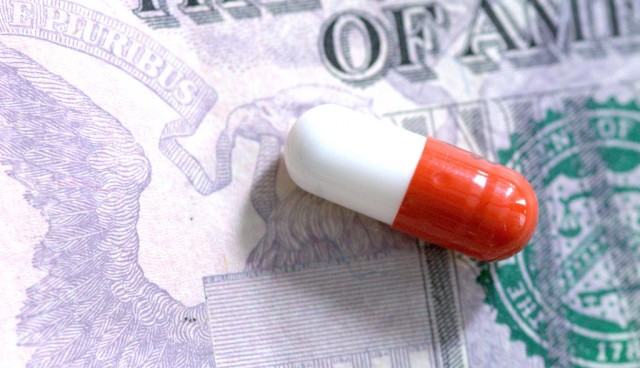The Real Cost of Prescription Drugs

Last night, I left the office around 8:30 so I could make it to a pharmacy before it closed and pick up some prescriptions. The young woman behind the counter asked me for my name, and then her eyes got wide for a few seconds before she said:
“Your copays are insane!”
I felt my stomach drop for a moment, and tried to reconcile that bad feeling with the thought that, no, I had great insurance — employer-sponsored health insurance that I had just re-selected during an open enrollment period in August. And then I remembered that the drug store that I used to go to near my apartment had closed, and that this pharmacy probably didn’t have any of that insurance information on file.
“Oh, here’s my insurance card,” I said, and as she typed my information into her system, I grabbed one of the bags with my name on it that she had placed on the counter. The dollar amount read: $1,034.09, for a bottle of antibiotics. “Um, yeah, that’s insane,” I said. “Wait, were you going to ring me up for that?”
I grabbed the other bag. “This is like, $1,500, total.”
She laughed. “Well, with your insurance, your total is now $90, thank goodness. Let me print this out.”
I walked home with the real dollar amounts of my prescriptions still floating in my mind. What a world, I thought.
This is precisely what our insurance companies would like us to think about: the real dollar amounts of our prescriptions. In 2009, This American Life teamed up with Planet Money for an episode called “Someone Else’s Money,” which was dedicated to looking at “the crazy Rube Goldberg system that we have for insurance in this country,” as Ira Glass put it.
Chana Joffe-Walt reported about a battle between health insurance companies and prescription drug companies. Here’s Joffe-Walt explaining our co-payment system:
If you don’t, say, run an insurance company, you probably hate copays. They’re a way to make you pay for your drugs at the pharmacy, even though you’re insured. Which seems kind of evil, right? But I tracked down an evil insurance VP, Eileen Wood, who actually was pretty personable. And she said, no, no, no. Copays are an insurers special little way of yelling at us. There are drugs that cost $1,000, there are drugs that cost $5. When you’re insured, you don’t care. You don’t even know. So the insurers put a $30 copay on one and $10 copay on the other. They’re giving you a hint that there is a difference in the drug’s total cost.
Eileen Wood: And the consumer doesn’t see that, and so we struggle to try to shine the light on that and get called the bad guy.
Chana Joffe: You do get called the bad guy a lot?
Eileen Wood: Yeah, we do.
So insurance companies use $50 and $30 and $10 copays to remind us how much our drugs cost, hoping to steer us to generic versions of brand name drugs so we pay the $10 copays rather than the $50 ones. They save money, and we save money. And saving money is a good thing, because it keeps our insurance premiums down. Joffe-Walt goes on to explain that prescription drug companies don’t want us to buy generics, so they often provide coupons to keep our co-payments low. That’s not such a good thing, because of the real-life costs of those drugs. Here’s the segment:
As for me, I’m glad I got to see the real dollar amount of these drugs (it’s also on the new forms that were printed out, but in such small print that I probably wouldn’t have noticed it or given it much thought) — it resulted in this post, after all. I went home. I poured myself a glass of water. There goes $50, I thought, swallowing.
Photo: David Goehring
Support The Billfold
The Billfold continues to exist thanks to support from our readers. Help us continue to do our work by making a monthly pledge on Patreon or a one-time-only contribution through PayPal.
Comments